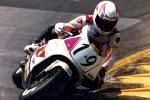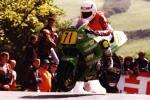Revved Up and Ready to Ride
Sunday Times
- 2 June 1996
By Alasdair Reid
On Tuesday afternoon, the mist came down on Snaefell, the highest mountain on the Isle of Man, and settled into its folds like a damp, discarded blanket. This is the cloak of Manannan, drawn over the island to hide it from foreign invaders, yet while a thousand years of Manx independence suggest that the Celtic sea god once knew what he was doing, these days he seems to be fighting a losing battle.
On the sea front at Douglas, the invaders were gathering in their thousands. A two-wheeled army of pilgrimage, undeterred by such sombre camouflage or the prospect of hotels where elegance is mostly of the faded variety. A multi-national throng, too, pouring from the ferry King Orry to pay homage to legends of their own.
The Manx authorities call their island the road-race capital of the world, yet even in practice week their claim seemed flawed by an excess of modesty. As sacred as they are celebrated, the 37.73 miles of its Tourist Trophy circuit - formed by the simple expedient of closing a few public roads - lure 500 competitors and 40,000 spectators every year, drawn by a beguiling mixture of history, tradition and the purity of the sport. To think of it merely as a sporting venue is to miss the point by a distance.
You only have to drive round the course once to appreciate that the roadside marker boards form the most evocative gazetteer in motorcycle racing. West. out of Douglas, the road takes you past Braddon Bridge and Crosby then north from Ballacraine. Past Cronk-y-Voddy, Ballaugh Bridge and Selby, it then loops south from Ramsey over the famous Mountain section. The ascent is relatively gentle, but the downward sweep is a furious and exhilarating charge through the bends of Windy Corner and Creg-ny-Baa and on to Governor's Bridge, the last of the circuit's 264 corners on the entry to the finishing straight.
By any measure, not least the fact that it has claimed around 160 lives since racing began in 1911 - and another four last week - it is a challenging course. After all the Bloodbath Island headlines of recent years, the organisers are prickly to the point of paranoia, pointing out that, with 400,000 racing miles every year, its record is no worse than others. Yet even they recognise that the most difficult corner on the course is its learning curve, and newcomers to the island are granted the concessions of slower qualifying times. Francesca Giordano, who will compete in tomorrow's lightweight race and in the Junior TT on Wednesday, first came to the island in 1993. Her inexperience was exposed when she fell from her bike during practice, slid 30 yards into a wall, and had to be taken to hospital. She ended up in a neck brace, but still competed the following week, albeit chastened by the experience. She knows now that the course deserves respect. "If you are used to circuit racing and you come here, where there are telegraph poles and walls everywhere, you tend to go a little slowly at first. It takes a lot of time to learn. But now I know the places where I can go faster. I am getting used to the speed in those streets where my instincts tell me to go slowly, but I still need as much practice as possible." As one of only three women entrants, and one, of only two Italians, Francesca Giordano is hardly the typical TT competitor. Yet it. is arguable whether such a creature really exists, for outside the select few stars, the rest of the TT field is drawn from an impressively wide range of backgrounds and nationalities, enthusiasm being their only common factor. Behind the grandstand are a handful of works teams with their motor-homes and liveried lorries, but the most common transport by far is the hired van of the privateer.
Clearly, part of the appeal of the TT is that it forms such a broad church. Yet this is an institution founded on democratic principles where, in a paddock mercifully free of the caste systems found in other forms of motorsport, it takes an expert eye to distinguish the established hero from the optimistic newcomer. While other forssuffer from cynical elitism, road racing is still a healthy meritocracy, its machinery more closely based on production machines and its stars almost invariably people's champions, hailed for their expertise on roads that are open to everyone else almost every day of they year.
Joey Dunlop, the Honda works rider from Ballymoney who will be trying to extend his record of 19 TT wins in four races this week, is feted as much for his background as a lorry driver and steel erector as his mastery of a course he can lap at around. 120mph. Likewise Mike Hailwood, who was acclaimed not only for his astonishing win, but for his loyalty, when he returned to race on the island in 1979, when grand prix stars like Sheene and Agostini turned their backs on the event.
"The TT is the most beautiful race in the world," says Giordano. "It's what every motorcyclist would like to do - going as fast as possible on the road. When you ride here you find that all the world has come to watch the races. You know of the famous people who have raced here before. Every part of the island has a story and you feel that you are a part of it. It's very fascinating, more than just a race."
While the course itself inspires awe and respect among riders, it angers Giordano that its killer reputation has been bolstered by recklessness, both of TT followers, who have tried to match their speeds, and by press coverage that has failed to distinguish their deaths from those of real racers. Jack Wood, clerk of the course and a TT rider in the 1950s, understands the allure, but cautions newcomers against excess.
"Here you've got to be a thinking rider, very much so, because of the nature of the course. With hedges and walls and all the rest of it, it's a course not to fall off on. A lot of the kerbs are chamfered, but everything beyond that is a danger area. It's a hard course and it takes time to learn and it's unusual for anyone to go well on his first year."
"If someone is going fast we'd be worried about it, we'd be talking to him about it in fact. We'd want to know if he realised he was on the TT course and if he really knew what he was doing. The pleasure of riding here is so great that you can get obsessed with it and forget about other factors. We just like to stop them and make them think."
The charm of the Isle of Man is mirrored by a course, and weather conditions, of beguiling variety. This week, as the riders blast away from the startline, head down Bray Hill and over Quarter Bridge, they will say a quiet prayer for a circuit free of Mannanan's cloak, or any other shroud.
![[Francesca Romana Giordano]](images/template/header-francesca.jpg)
![[Francesca on her Bike]](images/template/header-bike.jpg)









